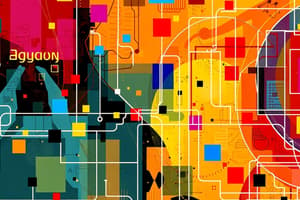Podcast
Questions and Answers
What is Human Computer Interaction (HCI)?
What is Human Computer Interaction (HCI)?
HCI is an area of research and practice that emerged in the late 1970s and early 1980s, focusing on the design and interaction between humans and computers.
Which of the following decades saw the rise of the personal computer?
Which of the following decades saw the rise of the personal computer?
- 1990s
- 2000s
- 1970s (correct)
- 1980s
What does GUI stand for?
What does GUI stand for?
- Graphical User Interface (correct)
- General User Interface
- Graphical Usage Indicator
- General Usage Interface
What significant development in HCI occurred in the 1990s?
What significant development in HCI occurred in the 1990s?
Name one kind of mobile technology mentioned in the content.
Name one kind of mobile technology mentioned in the content.
What does the interaction in HCI refer to?
What does the interaction in HCI refer to?
The context in HCI refers to the physical devices used.
The context in HCI refers to the physical devices used.
List three of Donald A. Norman's principles mentioned in the content.
List three of Donald A. Norman's principles mentioned in the content.
The ____ is considered the user or end-user in HCI.
The ____ is considered the user or end-user in HCI.
Which aspect of HCI does 'computer' specifically focus on?
Which aspect of HCI does 'computer' specifically focus on?
What is the primary focus of interaction in HCI?
What is the primary focus of interaction in HCI?
What does context in HCI refer to?
What does context in HCI refer to?
Which principle is specifically concerned with how easily a user can perceive the available options in a system?
Which principle is specifically concerned with how easily a user can perceive the available options in a system?
In the context of design principles, what does 'affordance' refer to?
In the context of design principles, what does 'affordance' refer to?
What significant change did the introduction of the Graphical User Interface (GUI) bring to computing?
What significant change did the introduction of the Graphical User Interface (GUI) bring to computing?
Which of the following best describes how HCI has evolved since the late 1970s?
Which of the following best describes how HCI has evolved since the late 1970s?
What was one of the key developments in HCI during the 1990s?
What was one of the key developments in HCI during the 1990s?
In which decade did mobile computing become increasingly prominent?
In which decade did mobile computing become increasingly prominent?
Which aspect does HCI encompass aside from the technological elements?
Which aspect does HCI encompass aside from the technological elements?
What influence did cognitive science have on HCI?
What influence did cognitive science have on HCI?
Which component of HCI focuses on user experience and ease of use?
Which component of HCI focuses on user experience and ease of use?
What role does the Internet play in modern HCI applications?
What role does the Internet play in modern HCI applications?
Flashcards are hidden until you start studying
Study Notes
History of Human Computer Interaction
- Human Computer Interaction (HCI) emerged in the late 1970s and early 1980s as a field in Computer Science.
- It expanded rapidly for three decades, attracting professionals from various disciplines.
- The 1970s saw the rise of personal computers and the development of cognitive science, which incorporated disciplines like psychology, artificial intelligence, linguistics, and anthropology.
- In the 1980s, the Graphical User Interface (GUI) was introduced, making computers easier to understand and use.
- The 1990s brought the internet and collaborative works, revolutionizing communication.
- The 2000s saw the rise of mobile computing, with mobile phones, PDAs, and smartphones becoming ubiquitous.
Four Major Components in HCI
- Human: Represents the user or end-user. Human limitations in processing information directly influence design decisions.
- Computer: Refers to the technology involved, encompassing input devices, output displays, memory, processing, and various display forms.
- Interaction: Addresses the communication between the user and the system. Interaction models help analyze and understand the processes involved.
- Context: Encompasses the environment and circumstances surrounding the interaction, driving design choices for usability and effectiveness.
Fail Designing
- This is a concept referring to the idea that designers shouldn't focus solely on making perfect interfaces, but rather understand the inevitable failures that can occur in human-computer interaction.
- In this way, designers can work toward creating more robust and flexible interactions that can gracefully accommodate mistakes.
Don Norman Principles
- These principles are crucial for creating intuitive and user-friendly interfaces:
- Visibility: The system's elements and their functionalities should be visible and readily apparent.
- Feedback: The system should provide timely and informative feedback to users about the outcome of their actions.
- Constraints: The system should limit user choices and actions to reduce errors and guide them towards appropriate usage.
- Mapping: User actions should have a clear and intuitive relationship to system outcomes.
- Consistency: Similar elements and actions should behave the same way across the system, maintaining a consistent user experience.
- Affordance: The appearance of an object should clearly suggest its possible functions.
Six Concepts in Designing
-
These design concepts contribute to visually appealing and effective user interfaces.
- Balance: Creates visual equilibrium within the interface for a harmonious appearance.
- Contrast: Distinguishes elements from each other using color, size, or other visual cues for clarity and focus.
- Proximity: Group related elements together to enhance organization and comprehension.
- Repetition: Applies consistent patterns across the interface for visual consistency and recognition.
- White Space: Refers to intentional gaps around elements, creating visual breathing room and improving clarity.
- Alignment: Organizes elements consistently to create a visually cohesive and structured interface.
Human Computer Interaction (HCI)
- Multidisciplinary field focused on designing computer technology and human-computer interaction
- Considers physical, psychological, and theoretical aspects of interaction processes
- Initially emerged in the 1970s as a part of Computer Science and has expanded rapidly since then
- Influenced by cognitive science (cognitive psychology, artificial intelligence, linguistics, cognitive anthropology, philosophy of mind)
History of HCI
- 1970s: Rise of personal computers
- 1980s: Introduction of Graphical User Interface (GUI), which simplified computer use by replacing command prompts with a visual interface
- 1990s: The internet and collaborative work became increasingly common, leading to new technologies and communication advancements
- 2000s: Mobile Computing and Beyond, with smartphones, PDAs, and mobile phones dominating the market and offering a wide range of services
Four Major Components of HCI
- Human: The user/end-user, who has limited information processing capacity
- Computer: The system that includes input devices, output displays, virtual reality systems, various displays, paper output, memory, and processing
- Interaction: The processes of understanding what the user wants and how the system responds
- Context: The environment and paradigms used to design usable interactive systems, spanning from early computers to contemporary ubiquitous and context-aware computing
Donald A. Norman's Principles
- Visibility: Ensuring that relevant parts of the system are clearly visible to the user
- Feedback: Providing clear and timely feedback to the user on their actions
- Constraints: Limiting the possible actions a user can perform to prevent errors
- Mapping: Establishing a natural and logical relationship between controls and their effects
- Consistency: Maintaining consistency in the design of the system, including layout, terminology, and actions
- Affordance: Designing objects in a way that suggests their possible use (e.g., making a button look like a button to indicate it can be pressed)
Design Concepts
- Balance: Creating visual equilibrium by distributing elements symmetrically or asymmetrically
- Contrast: Using visual differences to highlight elements and create visual interest
- Proximity: Grouping related elements together to create visual unity and make information easier to scan
- Repetition: Repeating visual elements to create consistency and rhythm
- White Space: Using blank space to separate elements and improve visual clarity
- Alignment: Arranging elements in a consistent manner to create a sense of order and visual coherence
Studying That Suits You
Use AI to generate personalized quizzes and flashcards to suit your learning preferences.




